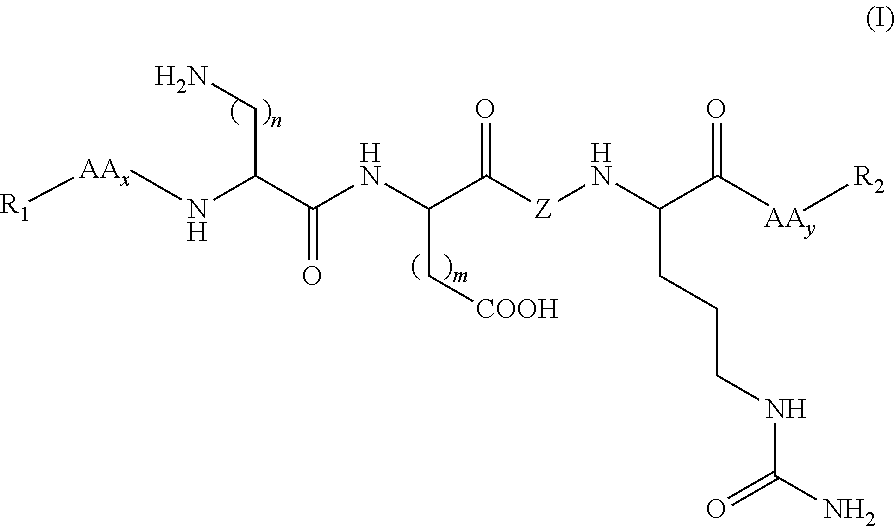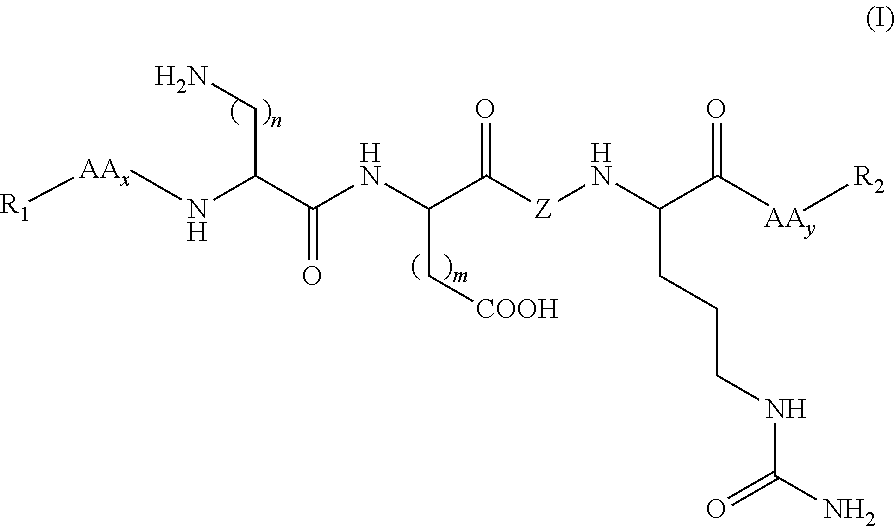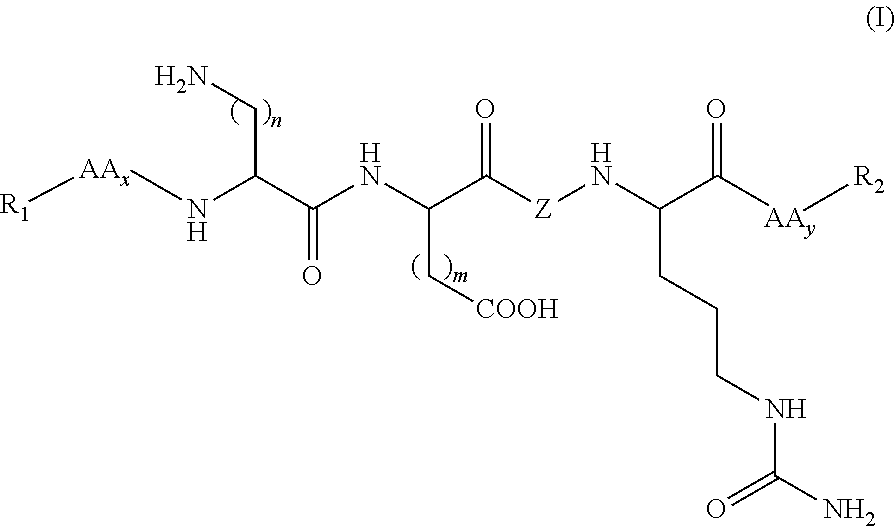Synthetic peptides useful in the treatment of the sking and use thereofe in cosmetic or dermopharmaceutical compositions
a technology of synthetic peptides and fibrillogenesis, which is applied in the direction of peptide sources, peptide/protein ingredients, drug compositions, etc., can solve the problems of transgenic animals having an increased collagen degradation, poor skin quality, and damage to the architecture of collagen,
- Summary
- Abstract
- Description
- Claims
- Application Information
AI Technical Summary
Benefits of technology
Problems solved by technology
Method used
Image
Examples
example 1
Obtaining Palm-Dap-Glu-Ile-Cit-OH
[0081]3.5 g of Fmoc-L-Cit-OH (8.8 mmol, 1 equiv) dissolved in 55 mL of DCM to which 1.3 mL of DIEA (7.6 mmol, 0.86 equiv) have been added were incorporated to the dry 2-chlorotrityl resin (5.5 g, 8.8 mmol). It was left stirring for 5 minutes, after which 2.5 mL of DIEA (14.6 mmol, 1.66 equiv) were added. It was allowed to react for 40 minutes. The remaining chloride groups were blocked by treatment with 4.4 mL of MeOH.
[0082]The amino terminal Fmoc group was deprotected as described in general methods and 7.77 g of Fmoc-L-Ile-OH (22 mmol, 2.5 equiv) were incorporated to the peptidyl-resin in the presence of DIPCDI (3.39 mL, 22 mmol, 2.5 equiv) and HOBt (3.37 g, 22 mmol, 2.5 equiv) using DMF as a solvent for 1 hour. The resin was subsequently washed as described in general methods and the treatment for deprotecting the Fmoc group was repeated to incorporate the next amino acid. By following the described protocols, 9.36 g of Fmoc-L-Glu(OtBu)-OH (22 mmo...
example 2
Synthesis of H-Lys-Asp-Val-Cit-NH2
[0085]0.685 mg of the Fmoc-AM-MBHA resin with a functionalization of 0.73 mmol / g (0.5 mmol) with piperidine-DMF according to the described general protocol for the purpose of eliminating the Fmoc group. 0.99 g of Fmoc-L-Cit-OH (2.5 mmol, 5 equiv) were incorporated to the deprotected resin in the presence of DIPCDI (385 μL, 2.5 mmol, 5 equiv) and HOBt (385 mg, 2.5 mmol, 5 equiv) using DMF as a solvent for 1 hour.
[0086]The resin was subsequently washed as described in general methods and the treatment for deprotecting the Fmoc group was repeated to incorporate the next amino acid. By following the described protocols, 0.85 g of Fmoc-L-Val-OH (2.5 mmol, 5 equiv), 1.03 g of Fmoc-L-Asp(OtBu)-OH (2.5 mmol, 5 equiv) and 1.17 g of Fmoc-L-Lys(Boc)-OH (2.5 mmol, 5 equiv) were sequentially coupled in the presence in each coupling of 385 mg of HOBt (2.5 mmol, 5 equiv) and 385 μL of DIPCDI (2.5 mmol, 5 equiv).
[0087]The N-terminal Fmoc group was deprotected as d...
example 3
Obtaining Ac-Om-Asp-Thr-Cit-NH—(CH2)9—CH3
[0090]1.28 g of Fmoc-L-Cit-OH (3.23 mmol, 1 equiv) dissolved in 20 mL of DCM to which 500 μL of DIEA (2.9 mmol, 0.90 equiv) have been added were incorporated to the dry 2-chlorotrityl resin (2.0 g, 3.3 mmol). It was left stirring for 5 minutes, after which 1 mL of DIEA (5.9 mmol, 1.81 equiv) was added. It was allowed to react for 40 minutes. The remaining chloride groups were blocked by treatment with 1.6 mL of MeOH.
[0091]On 1 mmol of the aminoacyl-resin, the amino terminal Fmoc group was deprotected as described in general methods and 1.99 g of Fmoc-L-Thr(tBu)-OH (5 mmol, 5 equiv) were incorporated in the presence of DIPCDI (770 μL, 5 mmol, 5 equiv) and HOBt (770 mg, 5 mmol, 5 equiv) using DMF as a solvent for 1 hour. The resin was subsequently washed as described in general methods and the treatment for deprotecting the Fmoc group was repeated to incorporate the next amino acid. By following the described protocols, 2.06 g of Fmoc-L-Asp(Ot...
PUM
| Property | Measurement | Unit |
|---|---|---|
| diameter | aaaaa | aaaaa |
| diameter | aaaaa | aaaaa |
| time | aaaaa | aaaaa |
Abstract
Description
Claims
Application Information
 Login to View More
Login to View More - R&D
- Intellectual Property
- Life Sciences
- Materials
- Tech Scout
- Unparalleled Data Quality
- Higher Quality Content
- 60% Fewer Hallucinations
Browse by: Latest US Patents, China's latest patents, Technical Efficacy Thesaurus, Application Domain, Technology Topic, Popular Technical Reports.
© 2025 PatSnap. All rights reserved.Legal|Privacy policy|Modern Slavery Act Transparency Statement|Sitemap|About US| Contact US: help@patsnap.com



